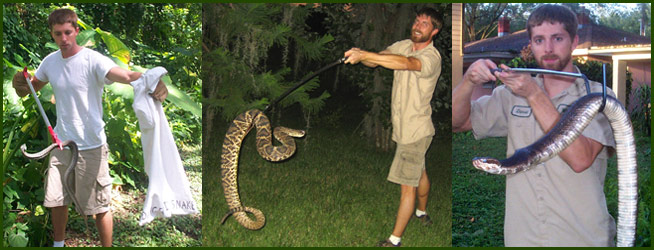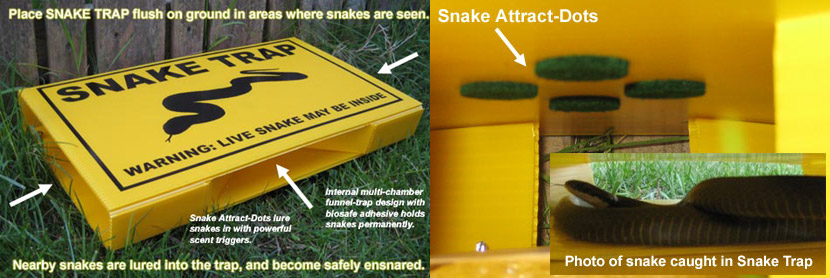1 - The safest option is to set a snake trap.
2 - The quickest option if you can't catch it yourself is to
hire a professional snake expert.
3 - If you can DEFINITELY identify the snake, and know that it
is non-venomous, then a grab with thick gloves is actually one
of the easiest methods to catch a snake. Place it in a pillow
case and relocate it elsewhere.
4 - If you don't want to handle the snake, and can't identify
it, or can't reach it, then a snake hook or snake tongs such as
seen below are the best way to catch it.
BUT REMEMBER - Most bites happen when people try to catch or
kill snakes, so maybe your best bet is to just leave it alone!
If you need it gone, a trap or an experienced pro is your best
bet. See the bottom of this page for either.

If you have a garden, and you enjoy spending hours bent over in
the heat of the day, few things will unnerve you like a thin,
long body suddenly slithering beneath your feet. The snake also
likes your garden, and he has been watching you while you pull
rocks and weeds out of the soil. If this scenario happens often
enough, you will probably become nervous when reaching into a
thick clump of vegetables, and eventually you will avoid your
garden all together. For someone who enjoys the fruits of their
labor, this abandonment is a terrible shame. Maybe, just maybe,
you should try to catch the snake.
Before you attempt to catch the snake, first verify what kind of
serpent you are dealing with. A poisonous snake will require a
special, if not professional, touch. As long as the snake is not
poisonous, you’re ready to begin.
First, you have to manage to re-enter your garden. You know this
is where the snake is located, so you will need to go in there
to catch it. With a long branch, yard stick, or fire poker, you
are going to distract the snake. Keep your tool near the snake’s
head, holding the animal’s focus. With your other hand, you are
going to reach down and pick up the snake’s tail. Keep the bulk
of the snake’s body on the ground. You never want to pick snake
up by just its tail! As quickly as possible, use your stick to
lift up the front end of the snake. At this point, one hand
should be holding the serpent’s tail and the other hand should
be holding the stick which is holding up the front part of the
snake. This positioning will allow you to control the body of
the reptile without putting yourself in danger. Move the snake
to a safe point of relocation. If you do not have access to a
nearby haven for the animal, you can place it in a pillowcase
and transport it by vehicle to a safe location. When releasing
the snake, gently point the head toward the direction you want
the snake to travel. If in a pillow case, gently spill the snake
out so that the body is partially still covered. Leave the
pillowcase on the ground and back away. When the snake has
slithered away, you may reclaim your linen.
If the above method is too direct, you can try to shoo the snake
into a large garbage bin. Place the bin on the ground and guide
the snake inside with a broom. Do not hit or push the snake
inside; you do not want to injure it. The smooth sides of the
bin will prevent the snake from climbing out and will allow for
safe relocation.
If your snake is inside the house, you can use a shirt and a
pillowcase to remove the pest. Throw your shirt or light blanket
over the snake and scoop it up, placing the shirt and snake into
the pillowcase. If you have a garbage bin or large storage bin,
place the pillowcase inside so the snake may come out if
desired. Place a lid with air holes over the container. Your
snake is now safe to transport. Read about Is
it safe to handle a snake with bare hands?
Professional grade snake traps are the safest method of snake
removal. While some traps are worthless, there are a few that
have been endorsed by wildlife professionals. These traps will
allow you to remove the snake from your property without having
to handle the snake itself. If you’re unsure what type of snake
you are dealing with, a hands-free method is the safest way to
go. Read about What
should I do with a snake after I catch it?
You basically have three options for catching your snake(s).
First, you can call a professional wildlife expert from my below
directory. This person can catch and remove the snake(s) and
take other actions necessary to solve the snake problem. Second,
you can purchase a snake trap if you wish to catch the snake
yourself. Third, you can modify your land and seal up your house
to help keep snakes away and out of the house, if you don't want
to figure out how to catch a snake in the first place.
Option 1 - HIRE A PROFESSIONAL
We can solve your snake problem for you. Our nationwide group of snake specialists services 95% of the US population. Click here to find your local snake removal expert in your town. Below are just some of our more popular areas:Option 2 - BUY A SNAKE TRAP
If a snake is indoors, a trap will work. I do not recommend using a glue-based trap outdoors, because it can inhumanely catch other small critters. I have reviewed and field tested several snake trap designs, and the one featured below is the most durable and effective. It is the highest quality snake trap available on the market. Read more about Snake Trap.
For more information, go to my Snake Removal - How to Get Rid of Snakes home page.
How to catch snakes - You can catch a snake by any means that does not put you or the animal at risk. The most hands-free method is that of a snake trap. Many professionals endorse the use of a box trap with glue pad and scent lures. The snake will be held firmly in place, alive, and can be taken to a new location to be released. You do not have to actively touch the snake, just pour vegetable oil on the glue pad and the animal will eventually work itself free. This is one of the safest methods to catch a snake. Because of their benefit to the environment, even venomous snakes are recommended for live release. If you are not worried about getting up close and personal with the serpent, you can use a snake hook or snake tongs to lift the snake, keeping it a safe distance from your body. Nonvenomous snakes are easily handled with thick gloves. Once the animal has been caught, place it in a pillowcase for relocation. Snakes will not strike through the pillowcase. They are visual hunters. Putting them in a closed area calms them. Attempting to catch a snake should only be done if you can identify the animal and determine that it is not venomous.
Read about Snake Enemies - Animals that Catch Snakes here.
Read more articles about snakes:
Where should I relocate a trapped snake?
How to get rid of snakes without killing them
What should I do if I find a nest of snakes?
Do snakes lay eggs or give live birth?